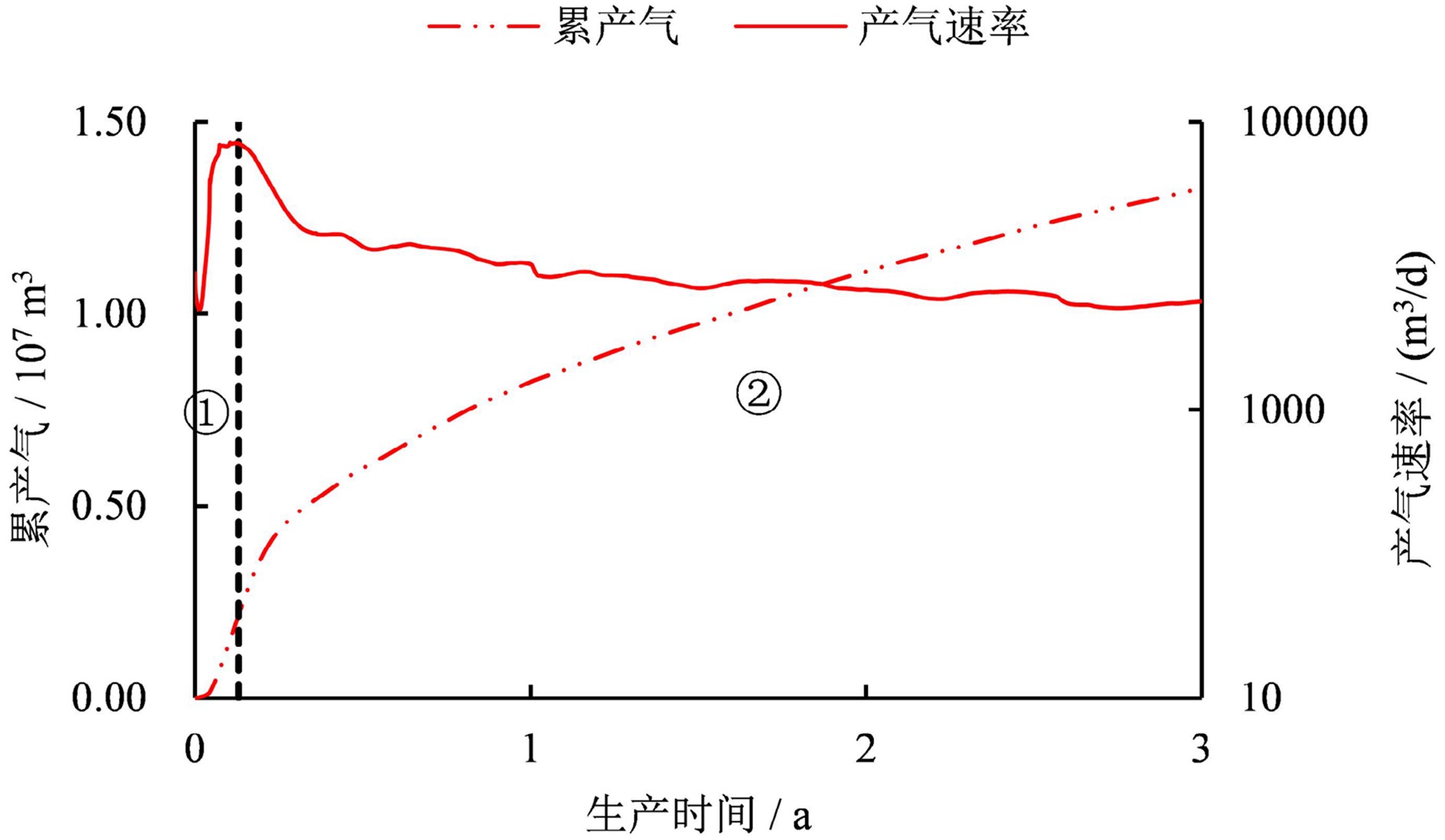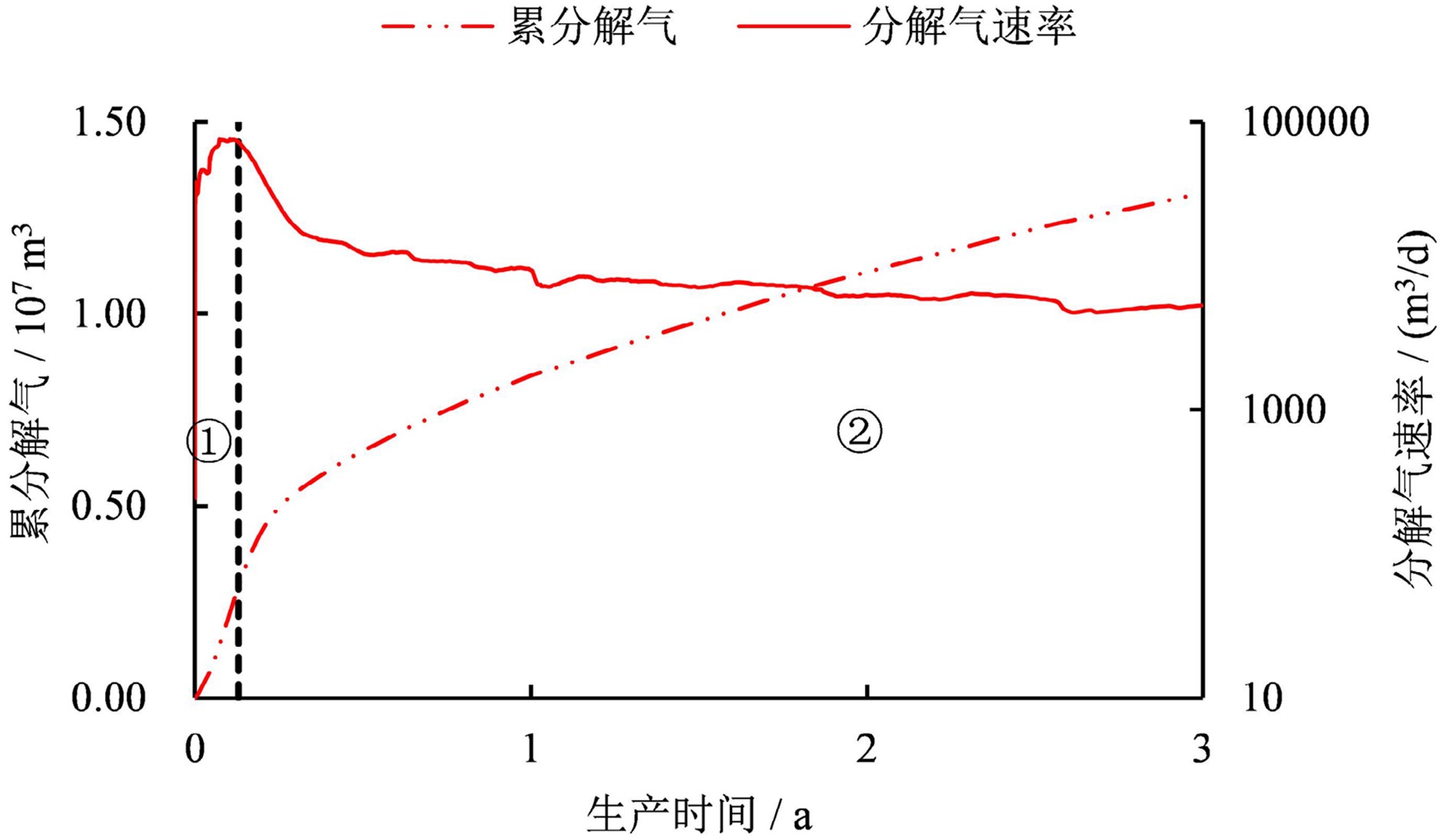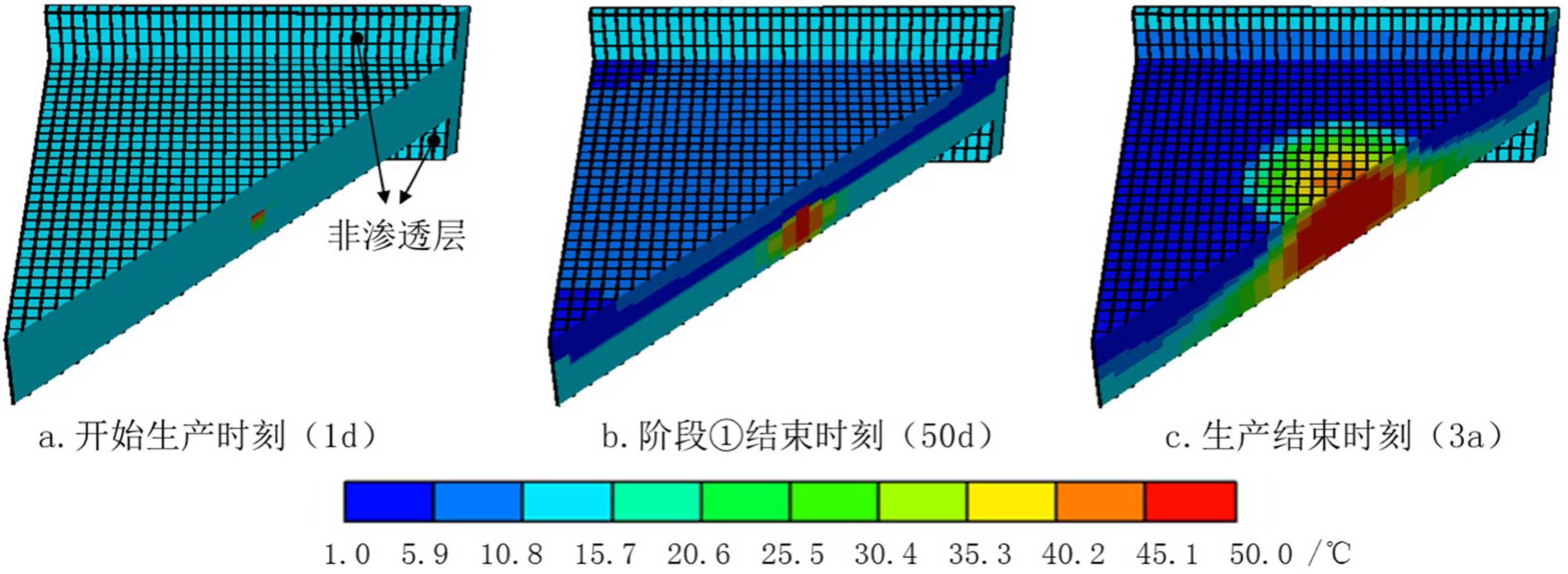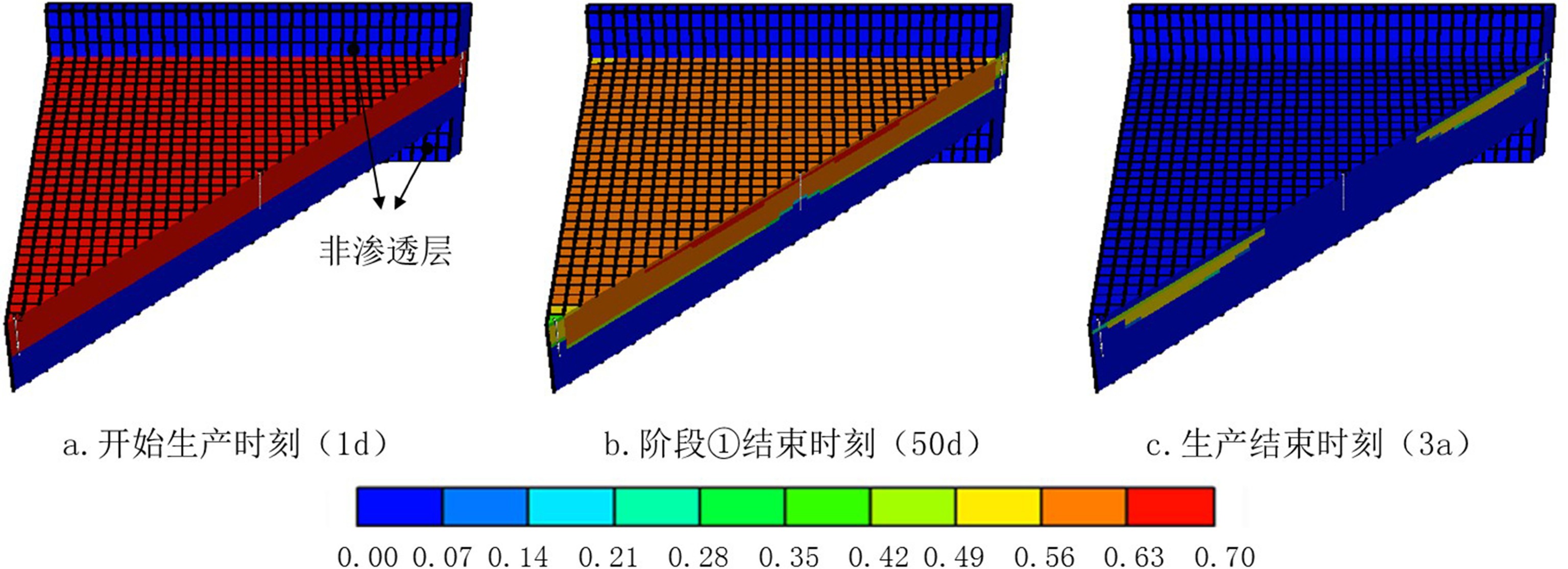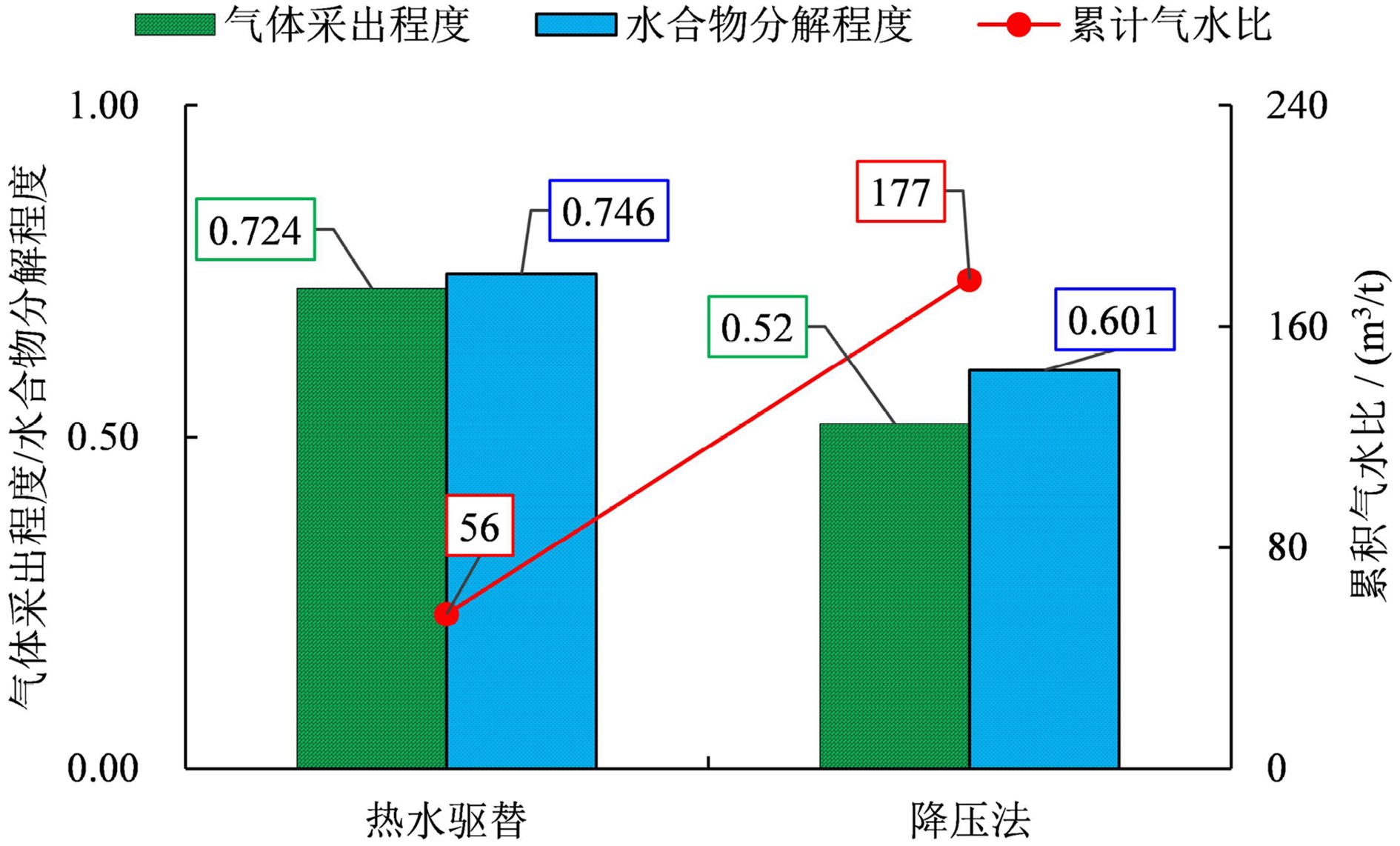Study of production of Class Ⅱ hydrate reservoir by hot water flooding
-
摘要:
天然气水合物广泛分布于陆地冻土带和深海地层,资源潜力巨大,其中Ⅱ类水合物藏占有重要地位。为加强对Ⅱ类水合物藏开采规律的认识,结合实际水合物藏参数,使用数值模拟方法研究了热水驱替开采Ⅱ类水合物藏的动态规律,并与降压法的开采效果进行了对比分析。结果表明:①热水驱替开采Ⅱ类水合物藏时,产气速率和分解气速率首先快速上升,然后以较快速度下降至趋于相对稳定;累产气和累分解气上升较快;气体采出程度和水合物分解程度均处于较高水平(>60%)。②热水驱替对Ⅱ类水合藏的开采具有一定的适应性,与降压法开采相比,热水驱替方式下储层水合物的分解更彻底,气体采出程度、水合物分解程度也更优,但具有较低的累积气水比,产水量较大。
Abstract:As a kind of new energy source, natural gas hydrates are widely distributed in both permafrost and deep ocean sediments. Among different types of hydrate reservoirs, the Class Ⅱ hydrate reservoir is the most prevalent production target. In order to study the behavior of the Class Ⅱ hydrate reservoir in production, this paper investigated the hydrate reservoir production using the hot water flooding method according to the parameters reported in literatures. The results are compared with those by the depressurization method. The results show: 1) when the Class Ⅱ hydrate reservoir is developed by hot water flooding, the gas production rate increases rapidly in the early stage, and then declines until it reaches a relatively stable level. The gas dissociation rate varies similarly to the gas production rate. The cumulative produced gas and dissociated gas increase rapidly at first, and then increase linearly. Both the gas recovery percent and hydrate dissociation percent remain on high levels (>60%). 2) the hot water flooding method is suitable for the Class Ⅱ hydrate reservoir development. Compared with the depressurization method, the hot water flooding method can achieve higher gas recovery percent and hydrate dissociation percent. But the gas-water ratio is higher, indicating a larger amount of water production.
-
Key words:
- Class Ⅱ hydrate reservoir /
- hot water flooding /
- production characteristics /
- comparison
-

-
图 1 水合物藏类型示意图(据文献[7]修改)
Figure 1.
表 1 基础模型参数
Table 1. Basic model parameters of the Class Ⅱ hydrate reservoir
参数 水合物层 下伏水层 顶底非渗透层 厚度/m 15 15 30 绝对渗透率/10−3 μm2 1 000 1 000 0 孔隙度 0.35 0.35 0 水合物饱和度 0.7 0 − 含水饱和度 0.3 1 − 底部初始压力/MPa 10.67 − − 底部初始温度/℃ 13.3 − − 温度梯度/(℃/100 m) 3.0 束缚水饱和度 0.20 − 束缚气饱和度 0.02 − -
[1] Bayles G A, Sawyer W K, Anada H R, et al. A steam cycling model for gas production from a hydrate reservoir [J]. Chemical Engineering Communications, 1986, 47(4-6): 225-245. doi: 10.1080/00986448608911766
[2] 王屹, 李小森. 天然气水合物开采技术研究进展[J]. 新能源进展, 2013, 1(1):69-79 doi: 10.3969/j.issn.2095-560X.2013.01.007
WANG Yi, LI Xiaosen. Research progress of natural gas hydrate production technology [J]. Advances in New and Renewable Energy, 2013, 1(1): 69-79. doi: 10.3969/j.issn.2095-560X.2013.01.007
[3] 张金华, 魏伟, 王红岩. 天然气水合物研究进展与开发技术概述[J]. 天然气技术, 2009, 3(2):67-69
ZHANG Jinhua, WEI Wei, WANG Hongyan. Research on gas hydrate and its development techniques [J]. Natural Gas Technology, 2009, 3(2): 67-69.
[4] Moridis G J, Collett T S. Strategies for gas production from hydrate accumulations under various geologic conditions[C]//Proceedings of TOUGH Symposium. Berkeley: Lawrence Berkeley National Laboratory, 2003.
[5] Moridis G J, Sloan E D. Gas production potential of disperse low-saturation hydrate accumulations in oceanic sediments [J]. Energy Conversion and Management, 2007, 48(6): 1834-1849. doi: 10.1016/j.enconman.2007.01.023
[6] Moridis G J, Reagan M T. Gas production from class 2 hydrate accumulations in the permafrost[C]//Proceedings of SPE Annual Technical Conference and Exhibition. Anaheim, California, USA: Society of Petroleum Engineers, 2007.
[7] Xia Z Z, Hou J, Liu Y G, et al. Production characteristic investigation of the Class Ⅰ, Class Ⅱ and Class Ⅲ hydrate reservoirs developed by the depressurization and thermal stimulation combined method [J]. Journal of Petroleum Science and Engineering, 2017, 157: 56-67. doi: 10.1016/j.petrol.2017.07.012
[8] Holder G D, Angert P F. Simulation of gas production from a reservoir containing both gas hydrates and free natural gas[C]//Proceedings of SPE Annual Technical Conference and Exhibition. New Orleans, Louisiana, USA: Society of Petroleum Engineers, 1982.
[9] McGuire P L. Methane hydrate gas production by thermal stimulation[C]//Proceedings of the Fourth Canadian Permafrost Conference. Calgary, Alberta, Canada, 1981.
[10] Sloan E D, Koh C. Clathrate Hydrates of Natural Gases[M]. 3rd ed. New York: CRC press, 2007.
[11] Sun Y H, Li B, Guo W, et al. Comparative analysis of the production trial and numerical simulations of gas production from multilayer hydrate deposits in the Qilian Mountain permafrost [J]. Journal of Natural Gas Science and Engineering, 2014, 21: 456-466. doi: 10.1016/j.jngse.2014.09.005
[12] Li X S, Xu C G, Zhang Y, et al. Investigation into gas production from natural gas hydrate: a review [J]. Applied Energy, 2016, 172: 286-322. doi: 10.1016/j.apenergy.2016.03.101
[13] 刘昌岭, 李彦龙, 孙建业, 等. 天然气水合物试采: 从实验模拟到场地实施[J]. 海洋地质与第四纪地质, 2017, 37(5):12-26
LIU Changling, LI Yanlong, SUN Jianye, et al. Gas hydrate production test: from experimental simulation to field practice [J]. Marine Geology & Quaternary Geology, 2017, 37(5): 12-26.
[14] 张炜, 邵明娟, 姜重昕, 等. 世界天然气水合物钻探历程与试采进展[J]. 海洋地质与第四纪地质, 2018, 38(5):1-13
ZHANG Wei, SHAO Mingjuan, JIANG Chongxin, et al. World progress of drilling and production test of natural gas hydrate [J]. Marine Geology & Quaternary Geology, 2018, 38(5): 1-13.
[15] Moridis G J, Kowalsky M. Depressurization-induced gas production from Class 1 and Class 2 hydrate deposits[C]//Proceedings of TOUGH Symposium. Berkeley, California: Lawrence Berkeley National Laboratory, 2006.
[16] Gao Y, Yang M J, Zheng J N, et al. Production characteristics of two class water-excess methane hydrate deposits during depressurization [J]. Fuel, 2018, 232: 99-107. doi: 10.1016/j.fuel.2018.05.137
[17] 杨圣文. 天然气水合物开采模拟与能效分析[D]. 华南理工大学博士学位论文, 2013.
YANG Shengwen. Simulation and energy efficiency analysis of gas production from hydrates[D]. Doctor Dissertation of South China University of Technology, 2013.
[18] Moridis G J, Reagan M T. Estimating the upper limit of gas production from Class 2 hydrate accumulations in the permafrost: 2. Alternative well designs and sensitivity analysis [J]. Journal of Petroleum Science and Engineering, 2011, 76(3-4): 124-137. doi: 10.1016/j.petrol.2010.12.001
[19] Reagan M T, Moridis G J, Zhang K N. Sensitivity analysis of gas production from class 2 and class 3 hydrate deposits[C]//Proceedings of Offshore Technology Conference. Houston, Texas, USA: Offshore Technology Conference, 2008.
[20] Feng J C, Wang Y, Li X S, et al. Production behaviors and heat transfer characteristics of methane hydrate dissociation by depressurization in conjunction with warm water stimulation with dual horizontal wells [J]. Energy, 2015, 79: 315-324. doi: 10.1016/j.energy.2014.11.018
[21] Bai Y H, Li Q P. Simulation of gas production from hydrate reservoir by the combination of warm water flooding and depressurization [J]. Science China Technological Sciences, 2010, 53(9): 2469-2476. doi: 10.1007/s11431-010-4036-y
[22] Moridis G J. Numerical studies of gas production from class 2 and class 3 hydrate accumulations at the Mallik Site, Mackenzie Delta, Canada [J]. SPE Reservoir Evaluation & Engineering, 2004, 7(3): 175-183.
[23] Moridis G J, Kowalsky M B, Pruess K. HydrateResSim User's Manual: A Numerical Simulator for Modeling the Behavior of Hydrates in Geologic Media[M]. Berkeley: USA, Lawrence Berkeley National Laboratory, 2005.
[24] Gamwo I K., Liu Y Mathematical modeling and numerical simulation of methane production in a hydrate reservoir [J]. Industrial & Engineering Chemistry Research, 2010, 49(11): 5231-5245.
[25] Moridis G J, Reagan M T, Kim S J, et al. Evaluation of the gas production potential of marine hydrate deposits in the Ulleung Basin of the Korean East Sea [J]. SPE Journal, 2009, 14(4): 759-781. doi: 10.2118/110859-PA
[26] Moridis G J, Reagan M T. Estimating the upper limit of gas production from class 2 hydrate accumulations in the permafrost: 1. concepts, system description, and the production base case [J]. Journal of Petroleum Science and Engineering, 2011, 76(3-4): 194-204. doi: 10.1016/j.petrol.2010.11.023
[27] Zhao J F, Liu D, Yang M J, et al. Analysis of heat transfer effects on gas production from methane hydrate by depressurization [J]. International Journal of Heat and Mass Transfer, 2014, 77: 529-541. doi: 10.1016/j.ijheatmasstransfer.2014.05.034
[28] Moridis G J, Kowalsky M B, Pruess K. Depressurization-induced gas production from class-1 hydrate deposits [J]. SPE Reservoir Evaluation & Engineering, 2007, 10(5): 458-481.
-



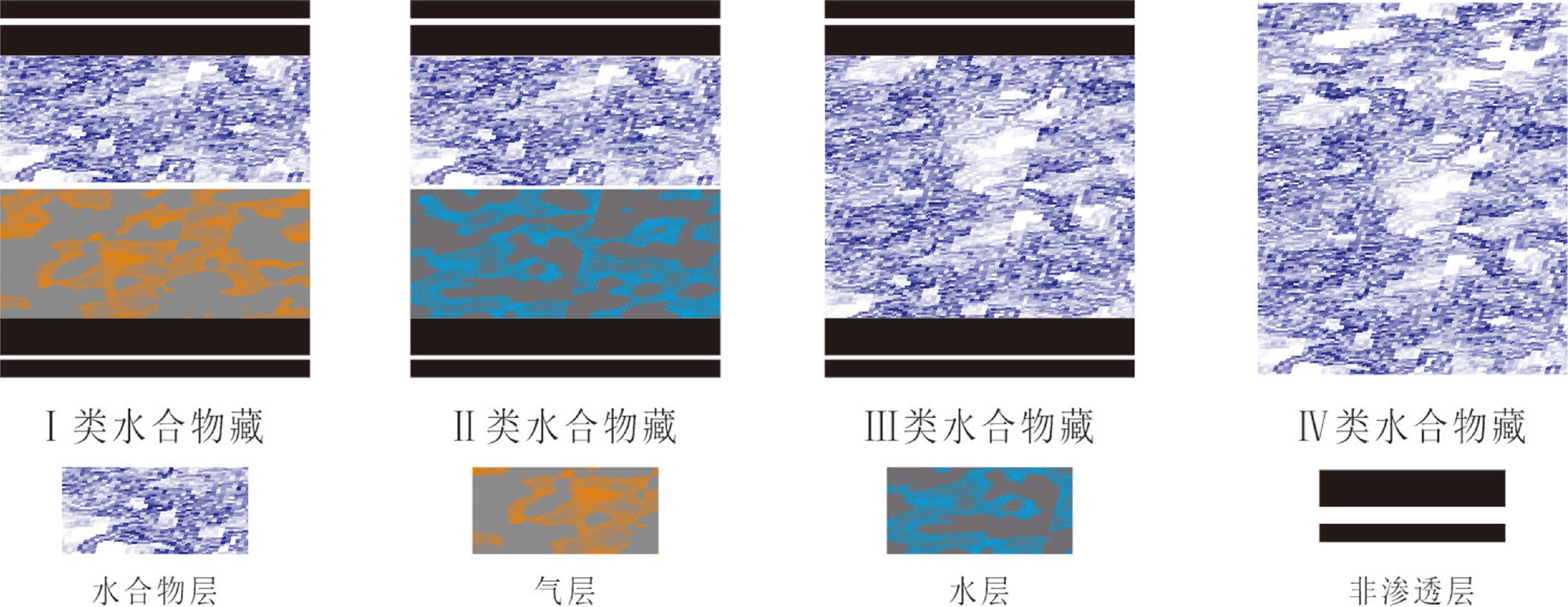
 下载:
下载:


